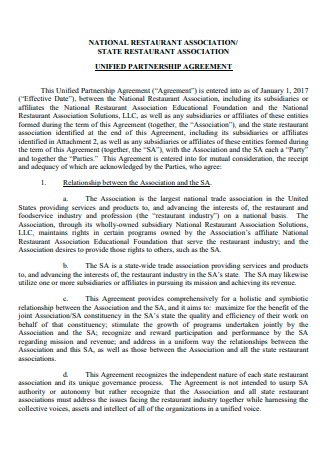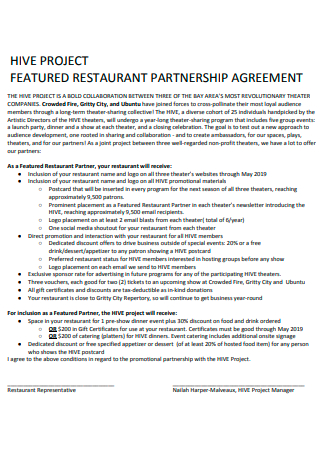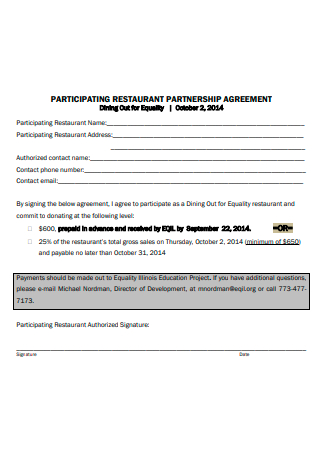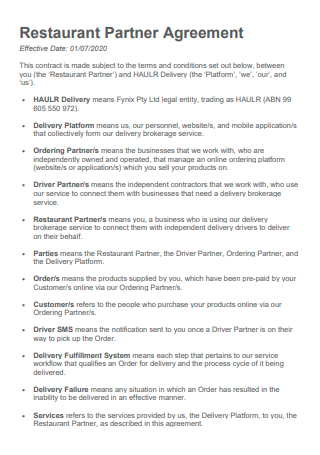3+ Sample Restaurant Partnership Agreement
FREE Restaurant Partnership Agreement s to Download
3+ Sample Restaurant Partnership Agreement
What Is a Restaurant Partnership Agreement?
Three Legal Structures for New Restaurants
How to Write a Restaurant Partnership Agreement
Key Tips to a Successful Restaurant Partnership
Terms to Include in a Partnership Agreement
FAQs
Is an agreement always a contract?
What is each partner’s financial contribution?
What are the four types of partnership?
What Is a Restaurant Partnership Agreement?
A Restaurant partnership agreement is a document signed by all parties engaged in the formation of a partnership. Each partner’s rights and obligations are outlined in the contract. To avoid future disputes and issues, the partners should write a formal restaurant partnership agreement before forming a general partnership. Although it is not required, creating your own partnership agreement to address the characteristics of your company is strongly advised. With that being said, this article has provided you with a restaurant partnership agreement sample that you can use and edit as much as you prefer.
Three Legal Structures for New Restaurants
Before you dive into the specifications of your restaurant or have your planned location inspected, you should first check into your restaurant’s legal structure possibilities. While there are a variety of alternatives accessible, Company owners cannot just choose one at random. You should consider the following factors such as the ideal size of the company, whether there are liability benefits, and if there is tax flexibility. For these cases, three business structures are ideal: a single person running the partnership, two or more partners, and entrepreneurs eager to start their own modest multi-unit chain.
How to Write a Restaurant Partnership Agreement
Coming up with an agreement form may be challenging if you are unaware of how to start one. Lucky for you, this article will guide you through each of the steps. A partnership agreement for Restaurant Business will be beneficial for your company and each of your partners should have a copy once it is finalized and signed.
Step 1: Write the Executive Summary
The Executive Summary is the first section that the readers, may they be the lawyers or your proposed partner, will encounter. It’s primarily used to provide investors and stakeholders, and of course, your partner with a quick summary of key information that is relevant to your restaurants. An executive summary can also provide other key points in the agreement such as the company description, market analysis, and financial data.
Step 2: State Benefits Each Party Will Receive
The next step requires you to list out the benefits that each partner will be receiving. It can be access to knowledge, skills, experience, and contacts, fewer legal obligations, ownership, and control are combined, or the job role they will be acquiring if they pursue to legalize the agreement. You should also define each of these details to clarify it and get it in actual writing rather than having the definition be changed later on.
Step 3: Define Clauses
As for the clauses, you will need to describe each partner’s rights and responsibilities, as well as how the partners will conduct the business and how the partnership can be terminated if required. Some of the clauses include capital contributions, acceptance of liabilities, duties, and responsibilities as partners, sharing and assignment of profits and losses, and most of all the manner to dispute resolutions.
Step 4: Include the Terms and Conditions
The terms and conditions are nothing more than a guide that each partner uses to clarify the terms of their participation and function in a partnership. Their function in the restaurant, the regulations that partners must follow when managing or funding the restaurant, and, lastly, the rules that govern the cancellation or suspension of their partnership engagement are just a few instances. You can proceed to the curated list below as this article provides you with the necessary terms to include in your restaurant partnership agreement or when coming up with a limited partnership deed.
Step 5: Signatures and Contact Information
Last but not least to include in your restaurant partnership agreement are the signatures and contact information of each involved partner. This is the crucial step to conclude your agreement because it serves as an acknowledgment for each party to have duly recognized and agreed upon on the details that are listed.
Key Tips to a Successful Restaurant Partnership
It’s not uncommon for family members and friends to open a restaurant together. Buying and managing a restaurant in a partnership may be far more successful in many cases. However, joining forces has its drawbacks, and both partners must agree on a range of concerns that come with owning and managing a restaurant before entering into a partnership. This curated list elaborates on things you should keep in mind to ensure a successful restaurant partnership. This is necessary before proceeding to a restaurant investment agreement to avoid misunderstandings in the future.
Terms to Include in a Partnership Agreement
Depending on the extent of corporate activities and the number of partners engaged, partnerships can be complicated. A partnership agreement is required to prevent the possibility of complexity or conflicts among partners in this sort of business organization. A partnership agreement is a legal contract that governs how a company is conducted and specifies each partner’s role. Although each partnership agreement is unique based on the business objectives, certain terms should be included in the document which you can find as you continue reading the list in this article. Keep these terms in mind as you write your partnership agreement.
FAQs
Is an agreement always a contract?
All legally binding agreements are referred to be Contracts. Although there may be agreements that aren’t contracts, there can’t be contracts that aren’t agreements. As long as the document has the necessary information, such as the terms, clauses, signature, and another relevant information present, it can be considered as a legal document. Most especially if it has been composed with a lawyer present, then the agreement is all the more valid.
What is each partner’s financial contribution?
Memory is fluid and untrustworthy. In the event of a subsequent conflict, you will want to make sure that each partner’s financial commitment to the partnership is set down in your partnership agreement. Certain partners may be able to give more starting cash than others. Others may be able to contribute in the form of sweat equity in this situation, which should be valued and described in the agreement.
What are the four types of partnership?
The formation of a general partnership does not need the formation of a commercial entity with the state. Limited partnerships consist of at least one general partner who is accountable for the company and one or more limited partners who give Financial support but don’t actively manage it. The limited liability partnership functions similarly to a general partnership, with all members actively managing the company, but it restricts their liability for the activities of the other partners. A limited liability limited partnership works similarly to an LP in that it has at least one general partner who oversees the company, but the general partner’s responsibility is restricted so all partners are protected.
Working with a partner or a partnering company will be fun and filled with thrill. You will have someone with you as you experience milestones and achievements in your restaurant. As well as share sadness if things go wrong and have someone think with you for possible solutions. Just don’t forget the presence and importance of a restaurant business partnership agreement!




